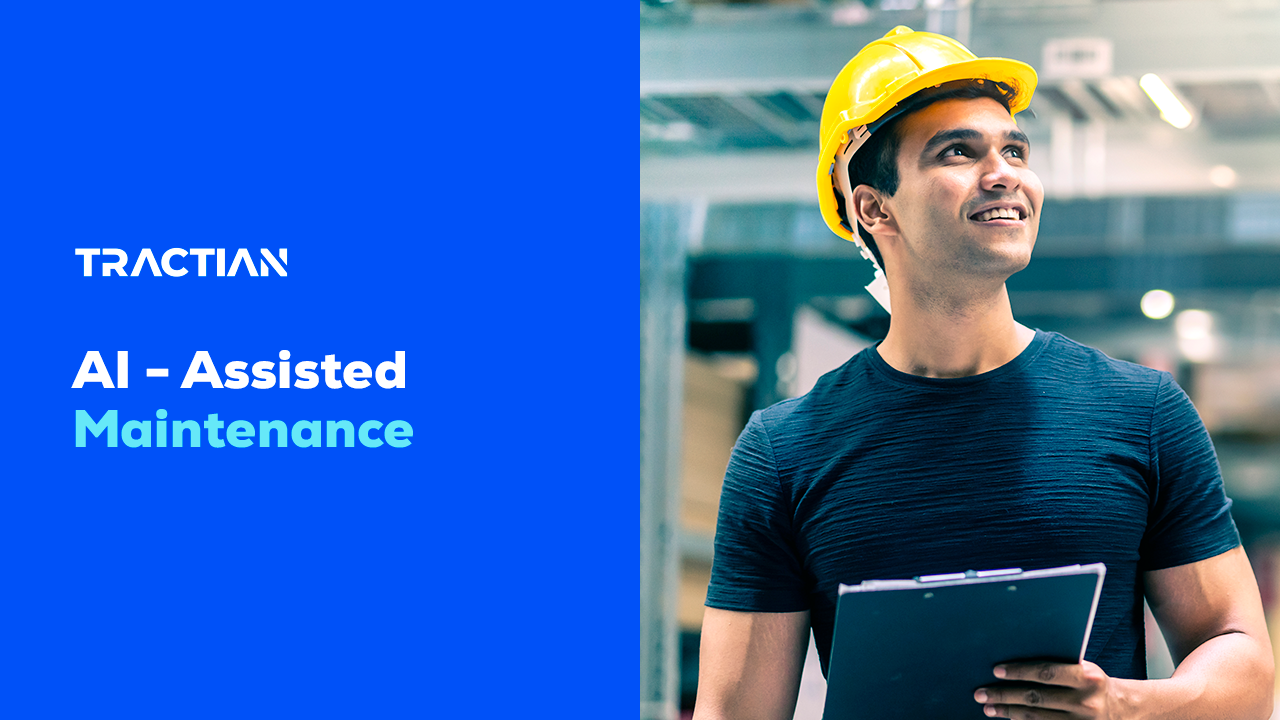What is AI-Assisted Maintenance? Discover How AI is Used in Predictive Maintenance
What are the maintenance headaches that keep you up at night? Have you heard of the essential technology that will erase all those nightmares? Welcome to the world of AI-assisted maintenance! This isn’t about fixing what’s already broken, it’s about getting a heads-up before things go south, and ensuring your operations continue to run smoothly.
At the heart of this is Artificial intelligence (AI), transforming data into predictions, and offering a heads-up on equipment issues before they disrupt operations. It’s like having a 24/7 monitor on your machinery, predicting problems and suggesting preemptive actions.
With the power of AI-assisted maintenance, you can eliminate downtime like never before and boost efficiency, all while keeping your maintenance costs in check.
That’s the power of AI in predictive maintenance. It isn’t just another category, it’s a powerful tool that goes beyond traditional methods. It empowers maintenance teams with unprecedented insights, unlocking results that were previously out of reach. With AI, maintenance professionals can achieve more than ever before.
Let’s dive into how AI-assisted maintenance is changing the game.
How AI is Used in Maintenance
AI predictive maintenance is about deep data dives and smart algorithms working overtime to spot trouble before it starts. Here’s the breakdown:
Data Analysis: AI starts with data-loads of it. From operational metrics to historical performance records, AI sifts through information to find patterns that humans might miss.
Machine Learning: This is where AI gets its predictive power. Machine learning algorithms learn from past data, making educated guesses about when equipment might fail. It’s like teaching your maintenance system to anticipate problems based on experience.
AI Algorithms: The real magic happens here. AI algorithms analyze real-time data, comparing it against historical trends to flag potential issues. These algorithms are constantly learning, constantly adapting, and always getting better at predicting what’s next.
In essence, AI predictive maintenance leverages the trifecta of data analysis, machine learning, and AI algorithms to keep your operations running smoothly.
It’s not just maintenance; it’s maintenance with a master’s degree in foresight.
How AI-Assisted Maintenance Impacts the Industry

AI-assisted maintenance is revolutionizing how industries approach equipment management, driving significant improvements in productivity and efficiency. Let’s break down its impact:
Improve “Overall Equipment Effectiveness” (OEE)
AI elevates OEE by ensuring equipment operates at its peak. By predicting failures before they happen, AI minimizes downtime and maximizes availability, performance, and quality.
It’s like being able to accurately predict the future, giving you insights to tweak and tune operations for optimal output.
Boosting “Total Productive Maintenance” (TPM)
TPM’s goal is to stop failures before they start, and AI is the turbo boost that was needed..
AI’s predictive insights help teams focus on preventive measures, reducing breakdowns and enhancing the lifespan of machinery. This proactive approach not only saves time and money but also fosters a culture of continuous improvement and teamwork.
Total “Planned Preventive Maintenance” (PPM)
With AI, PPM becomes a finely tuned orchestra. Scheduled maintenance is informed by AI’s predictive analytics, ensuring maintenance is done just in time, not just on a calendar schedule. This strategic approach reduces unnecessary maintenance, freeing up resources for where and when they’re truly needed, ensuring maintenance efforts are as efficient and effective as possible.
Other Benefits of Integrating AI in Predictive Maintenance Strategies
The integration of AI into predictive maintenance strategies extends far beyond just preempting equipment failures. Here’s a closer look at the primary benefits:
Reduced Downtime
AI’s ability to predict and prevent equipment failures translates directly into reduced downtime. By identifying potential issues before they escalate into full-blown problems, operations can continue without unexpected interruptions, keeping productivity high and losses low.
Extended Equipment Life
Regular AI-driven maintenance ensures that equipment is not just repaired when it breaks down, but is consistently maintained at its optimal condition. This careful and proactive approach significantly extends the lifespan of machinery, making the most out of every asset’s potential.
Improved Operational Efficiency
AI predictive maintenance streamlines the maintenance process itself. By prioritizing maintenance tasks based on actual need rather than a set schedule, resources are allocated more efficiently. Maintenance teams can focus their efforts where they’re needed most, enhancing overall operational efficiency.
Together, these benefits underscore the transformative impact of AI on maintenance strategies, offering a smarter, more efficient approach to keeping equipment running smoothly and operations flowing seamlessly.
AI-Assisted Maintenance: Bridging the Gap Between Data and Action

AI-assisted maintenance stands at the forefront of modern maintenance strategies, acting as the crucial link between raw data and actionable insights. Here’s how it operates:
AI doesn’t just collect data; it interprets it, transforming vast amounts of operational information into understandable, actionable recommendations. This process involves several key steps:
1. Descriptive Analysis - What happened?
AI systems start off by amassing data from multiple sources, like IoT sensors, machine logs, and past maintenance records. This initial step provides a descriptive overview of the equipment’s operational status, establishing the groundwork for AI’s analytical journey.
2. Diagnostic Analysis - Why did it happen?
Following data accumulation, AI applies sophisticated algorithms to dissect the information, detecting patterns, trends, and deviations. This diagnostic phase is where AI’s prowess truly comes to light, pinpointing early indicators of future faults which may go unnoticed by human oversight.
3. Predictive Analysis - What will happen?
AI’s analysis goes beyond immediate interpretation. It uses the diagnostic data to forecast future maintenance requirements. This predictive function allows maintenance teams to transition from a reactive to a proactive stance, effectively reducing unexpected downtimes and refining overall efficiency.
4. Prescriptive Analysis - What should be done?
The AI doesn’t stop at predictions. It converts its analytical conclusions into definitive, prescriptive insights for the maintenance team, ranging from pinpointed actions, like when to service a specific component, to wider operational strategies.
5. Assisted Decisions - What, where, and how do I do it?
Bridging the gap between analysis and action, AI facilitates decision-making by suggesting specific steps and methods for addressing maintenance issues, thereby supporting human participation in the decision-making process.
6. Supported and Automated Decision-Making:
Through these layers of analysis, AI fosters a dual-tiered decision-making framework where humans are aided in making informed choices or, when optimal, allowing AI to autonomously initiate maintenance protocols.
By bridging the gap between data and action, AI-assisted maintenance empowers maintenance teams with the knowledge and tools they need to act decisively and effectively, ensuring that operations run smoothly and efficiently.
Tractian, particularly its vibration sensors and Computerized Maintenance Management System (CMMS), exemplifies the cutting-edge of AI-assisted maintenance. These tools go beyond mere data collection and analysis; they are capable of self-diagnosis, offering not just insights but solutions.
AI-Assisted Maintenance: Staying Ahead of Issues, Increasing ROI
There are fundamentally two factors that determine the success of a maintenance strategy: cost reduction and machine availability. For businesses, the goal is straightforward - lower expenses while minimizing production downtime.
When a key piece of equipment unexpectedly fails, it can throw a wrench in your operations, causing significant losses in both production and manpower. These situations highlight the critical need for dependable machinery and effective cost management in manufacturing.
TRACTIAN revolutionizes maintenance by shifting it from a reactive expense to a strategic asset, ensuring your machinery is always ready to go. Our strategy extends beyond just supplying sensors; it’s about enhancing your operational uptime and efficiency with AI-assisted maintenance and AI-predictive maintenance, positioning TRACTIAN as an essential partner in achieving operational excellence.
TRACTIAN serves a diverse array of industry sectors, from small businesses to multinational corporations, spanning from the Food industries to Airline industries. Maintenance challenges have long been a source of sleepless nights for many, but with TRACTIAN’s innovative approach, we’re here to alleviate those concerns, transforming night-time worries into daytime successes.


